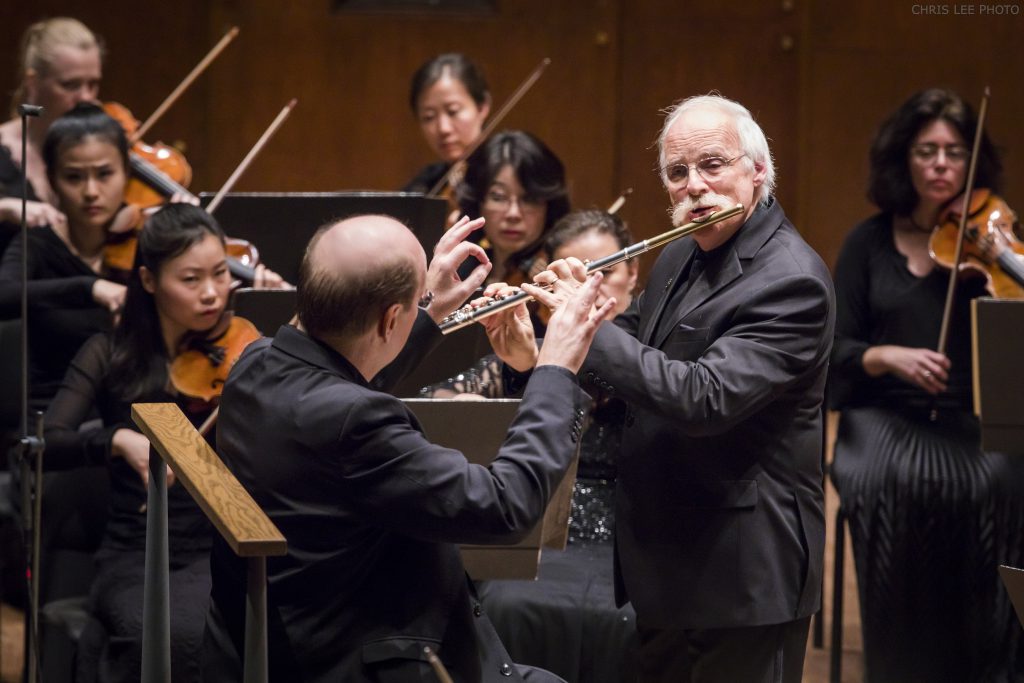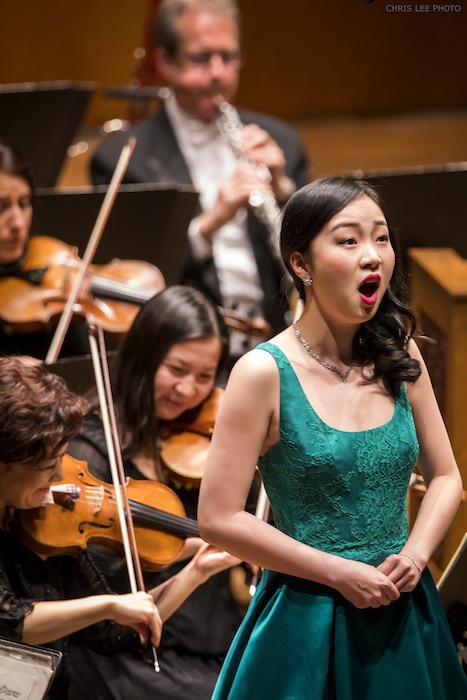Labadie, Philharmonic and soloists serve up the full Wolfgang, with élan and exuberance

Robert Langevin performed Mozart’s Flute Concerto No. 2 with Bernard Labadie conducting the New York Philharmonic Thursday night. Photo: Chris Lee
Allegro aperto–the unusual tempo marking at the beginning of Mozart’s Flute Concerto No. 2—means literally “open” and metaphorically “frank” and “straightforward.” Thursday night the New York Philharmonic, under Bernard Labadie’s direction, gave performances of that concerto and three other Mozart works that were about as aperto as you can get.
Seated on an upholstered piano stool and conducting without a baton, Labadie nevertheless infused the concerto, two symphonies and the motet Exsultate, jubilate with a driving energy that sometimes felt a bit excessive but mostly served the music well, thanks to the performers’ intense focus on the sound and message of the music.
When done as well as this, an up-tempo approach to Mozart’s scores has the effect of keeping his profusion of ideas airborne. There’s no time to stop and think, “Wait a minute—that modulation’s illegal.” There’s only the Mozart moment, served hot.
The program opened, however, with a work not overburdened with ideas, the Symphony No. 31 in D major (“Paris”), a piece in which Mozart is thought to have been catering to a French taste for the superficial and sensational. Labadie’s crisp, purposeful reading of the first movement was appropriately up-front, while not neglecting such Mozartean touches as the glow that winds imparted to light-footed strings, or the little sighs slipped into the festive coda.
Paris audiences liked their symphonies in three movements instead of four, but Labadie’s elegant rendering of the Andante suggested that Mozart found a way to make one piece serve as both slow movement and minuet. (Of the two Andantes Mozart composed for this symphony, the conductor selected the dance-like one in 3/4 time.)
In the last movement, Mozart finally let fly with contrapuntal complications to challenge the Parisians’ ears, and Thursday’s exuberant performance sounded like a tuneup for that last word in Classical-era counterpoint, the “Jupiter” Symphony.
It came as no surprise that Labadie turned the flute concerto’s opening exposition into a little poem in itself, setting the table for a delicious performance by Robert Langevin, the Philharmonic’s principal flutist, in the soloist’s role.
Playing with a minimum of fuss or moving about, Langevin gave rhythmic definition to his part’s fast passages and color and nuance to the lyrical moments. His tone, full-bodied without losing its breathy edge, was that of a flutist accustomed to making himself heard over a symphony orchestra.
Ideally, the slow movement would have a more arioso line than it had Thursday night, and the finale a more mischievous attitude, but everything was prettily phrased, and both movements gained energy as they went along.
An added attraction was the solo cadenzas Langevin composed for each movement, featuring some fancy overblowing effects but always in the Mozart spirit of tenderness and wit.

Ying Fang. Photo: Chris Lee
The solo motet Exsultate, jubilate received a somewhat edgy performance from Labadie, pushing the orchestra a bit for tempo, and soprano Ying Fang, sounding a little breathy with a tight vibrato. Although the rapid vocal roulades sounded blurred in the large hall, there was much to admire in the singer’s lively phrasing, and her voice interacted touchingly with the strings (especially the violas) in the third movement, “Tu virginum corona.” And if the effort showed a bit in the concluding “Alleluia,” the soprano nevertheless brought the virtuoso piece home in style.
Of the three great symphonies Mozart famously tossed off in the summer of 1788, No. 39 in E-flat major is sometimes considered the shy and retiring one, but not in Thursday’s performance, which recalled Haydn at his most vigorous. Even the graceful opening theme had tensile strength, and the development section really did develop a head of steam. The recapitulation kicked it up another notch still, lifting the seated conductor off his bench.
The ensuing Andante con moto took its “moto” seriously, without sounding hurried. At this tempo, the harmonic suspense never let up during either the soft, hesitant passages or the loud interjections.
In the shapely Menuetto, Labadie let listeners hear Mozart first contrasting the stomping rhythm with graceful violin phrases, then magically combining them in the closing passages.
This bold, Haydnesque performance concluded with one of Mozart’s best tributes to the older master, a one-theme rondo bursting at the seams with wit. Mozart’s scoring sparkled, and the sections tossed the twisty theme amongst each other with split-second timing and clear articulation.
And let it be noted that Labadie took all the indicated repeats throughout the evening, including the two halves of No. 39’s finale. (Mozart himself took some of the usual repeats out of the “Paris” Symphony, apparently not wanting to test the Parisians’ attention span.) The music and the performance were loaded with content on Thursday night, and it was worth missing a few trains home to hear it all again.
The program will be repeated 8 p.m. Friday and Saturday. nyphil.org; 212-875-5656.